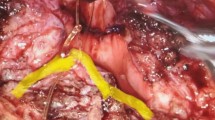Abstract
Purpose
To assess the efficacy and safety of thulium laser versus standard transurethral resection of the prostate (TURP) for treating patients with benign prostatic obstruction.
Methods
A systematic search of the electronic databases, including Medline, Embase, Web of Science, and The Cochrane Library, was performed up to February 1, 2014. The pooled estimates of demographic and clinical baseline characteristics, perioperative variables, complications, and postoperative efficacy including International Prostate Symptom Score (IPSS), quality of life (QoL), maximum flow rate (Qmax), and postvoid residual (PVR) were calculated.
Results
Seven trials assessing thulium laser versus standard TURP were considered suitable for meta-analysis including four randomized controlled trials (RCTs) and three non-RCTs. Compared with TURP, although thulium laser prostatectomy (TmLRP) needed a longer operative time [weighted mean difference (WMD) 8.18 min; 95 % confidence interval (CI) 1.60–14.75; P = 0.01], patients having TmLRP might benefit from significantly less serum sodium decreased (−3.73 mmol/L; 95 % CI −4.41 to −3.05; P < 0.001), shorter time of catheterization (WMD −1.29 days; 95 % CI −1.95 to −0.63; P < 0.001), shorter length of hospital stay (WMD −1.83 days; 95 % CI −3.10 to −0.57; P = 0.005), and less transfusion (odds ratio 0.09; 95 % CI 0.02–0.41; P = 0.002). During the 1, 3, and, 12 months of postoperative follow-up, the procedures did not demonstrate a significant difference in IPSS, QoL, Qmax, and PVR.
Conclusions
TmLRP had a similar efficacy to standard TURP in terms of IPSS, QoL, Qmax, and PVR, and offered several advantages over TURP in terms of blood transfusion, serum sodium decreased, catheterization time, and hospital stay, while TURP was superior in terms of operation duration. Well-designed multicentric/international RCTs with long-term follow-up are still needed.

Similar content being viewed by others
References
Bushman W (2009) Etiology, epidemiology and natural history of benign prostatic hyperplasia. Urol Clin North Am 36(4):403–415
Zhuo J, Xia SJ (2013) Is it necessary and feasible to increase the efficiency of 2-µm thulium laser resection of the prostate? Asian J Androl 15(4):453–454
Zhuo J, Wei HB et al (2014) Two-micrometer thulium laser resection of the prostate-tangerine technique for patients with acute urinary retention. Lasers Med Sci 29(3):1093–1098
Fried NM (2005) High-power laser vaporization of the canine prostate using a 110 W Thulium fiber laser at 1.91 micron. Lasers Surg Med 36(1):52–56
Fried NM, Murray KE (2005) High-power thulium fiber laser ablation of urinary tissues at 1.94 microm. J Endourol 19:25–31
Xia SJ, Zhang YN, Lu J et al (2005) Thulium laser resection of prostate-tangerine technique in treatment of benign prostate hyperplasia. Nat Med J China 85(45):3225–3228
Xia SJ (2009) Two-micron (thulium) laser resection of the prostate-tangerine technique: a new method for BPH treatment. Asian J Androl 11:277–281
Xia SJ, Zhuo J, Sun XW et al (2008) Thulium laser versus standard transurethral resection of the prostate: a randomized prospective trial. Eur Urol 53(2):382–389
Bach T, Xia SJ, Yang Y et al (2010) Thulium:YAG 2 lm cw laser prostatectomy: where do we stand? World J Urol 28(2):163–168
Wei HB, Shao Y, Sun F et al (2014) Thulium laser resection versus plasmakinetic resection of prostates larger than 80 ml. World J Urol 32(4):1077–1085
Wei HB, Zhuo J, Sun XW et al (2014) Safety and efficiency of thulium laser prostate resection for the treatment of benign prostatic hyperplasia in large prostates. Lasers Med Sci 29(3):957–963
Cui D, Sun F, Zhuo J et al (2014) A randomized trial comparing thulium laser resection to standard transurethral resection of the prostate for symptomatic benign prostatic hyperplasia: four-year follow-up results. World J Urol 32(3):683–689
Fu WJ, Zhang X, Yang Y et al (2010) Comparison of 2-microm continuous wave laser vaporesection of the prostate and transurethral resection of the prostate: a prospective nonrandomized trial with 1-year follow-up. Urology 75(1):194–199
Paweł Świniarski P, Stępień S, Dudzic W et al (2012) Thulium laser enucleation of the prostate (TmLEP) vs. transurethral resection of the prostate (TURP): evaluation of early results. Cent Eur J Urol 65(3):130–134
Shao JK, Wang YB, Lü YA, Li XD (2012) Comparison of 2 µm continuous-wave laser enucleation of the prostate and transurethral resection of the prostate for benign prostatic hyperplasia. Zhonghua Wai Ke Za Zhi. 50(2):131–134
Yan H, Ou TW, Chen L et al (2013) Thulium laser vaporesection versus standard transurethral resection of the prostate: a randomized trial with transpulmonary thermodilution hemodynamic monitoring. Int J Urol 20(5):507–512
Zhuo J, Xia SJ, Liu HT et al (2007) A comparative study of thulium laser resection of the prostate-Tangerine technique and transurethral resection of the prostate for the treatment of benign prostatic hyperplasia. Chin J Urol 01:38–41
Wells GA, Shea B, O’Connell D et al (2009) The Newcastle-Ottawa Scale (NOS) for assessing the quality if nonrandomized studies in meta-analyses. http://www.ohri.ca/programs/clinical_epidemiology/oxford.htm. Accessed 19 Oct 2009
Clarke M, Horton R (2001) Bringing it all together: lancet-Cochrane collaborate on systematic reviews. Lancet 357:1728
Xu Y, Sun DC, Yang Y et al (2013) 5-year follow-up to transurethral vaporesection of the prostate using the 2 micron continuous wave laser for the treatment of benign prostatic hyperplasia. Zhonghua Wai Ke Za Zhi. 51(2):119–122
Conflict of interest
None declared.
Ethical standard statement
Not required.
Author information
Authors and Affiliations
Corresponding authors
Additional information
Yiping Zhu and Jian Zhuo have contributed equally to this work.
Rights and permissions
About this article
Cite this article
Zhu, Y., Zhuo, J., Xu, D. et al. Thulium laser versus standard transurethral resection of the prostate for benign prostatic obstruction: a systematic review and meta-analysis. World J Urol 33, 509–515 (2015). https://doi.org/10.1007/s00345-014-1410-6
Received:
Accepted:
Published:
Issue Date:
DOI: https://doi.org/10.1007/s00345-014-1410-6




